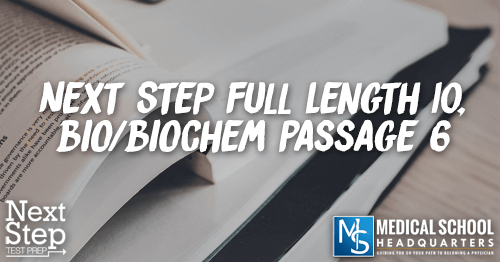Apple Podcasts | Google Podcasts

Session 126
Passage 6 is filled with lipoproteins, and maybe a little Hepatitis C. Follow along with the handout on our blog post for this MCAT bio/biochem passage.
We’re joined as always by Clara of Blueprint MCAT (formerly Next Step Test Prep). Need MCAT Prep? Save on tutoring, classes, and full-length practice tests by using promo code “MSHQ” for 10% off Next Step full-length practice tests or “MSHQTOC” for $50 off MCAT tutoring or the Next Step MCAT Course at Blueprint MCAT (formerly Next Step Test Prep)!
[02:08] Passage 6
Lipoproteins are composed of a neutral lipid core of cholesterol esters and triglycerol surrounded spherically by amphipathic phospholipids, non-esterified cholesterol, and apolipoproteins. The contents of the neutral lipid core may be synthesized de novo or obtain exogenously from the diet. Chylomicrons contain the smallest percentage of protein and the largest percentage of lipids. While HDL and VLDL displayed the highest and second highest protein to lipid ratio respectively of the lipoproteins. The apolipoproteins serve a variety of diverse functions including as coenzymes or activators or enzymes involved in lipoprotein metabolism and as recognition sites for cellular receptors. The apolipoprotein B portion of the lipoprotein LDL is one example. It’s binding by LDL’s specific receptors in liver cells triggers LDL’s endocytosis, digestion, and the removal of LDL which is rich in cholesterol from circulation. A group of students studying lipoproteins in a laboratory class conducted two experiments.
Experiment 1: The student separated serum lipoproteins by density gradient ultracentrifugation in which specific lipoproteins are separated into five sharply banded fractions according to their individual densities. Albumin, fatty acids, steroid hormones, antibodies, serum proteins, and other components were separated as sediment. The identity of each band was confirmed quantitatively by densitometry.
Experiment 2: Students were then given four unknown samples containing a single lipoprotein either VLDL, LDL, HDL or Chylomicrons. Students treated each sample with SDS. Each of the four SDS treated fractions was then isoelectrically focused at a constant voltage for 90 minutes.
**Note: This passage is throwing off terms that you probably should know and don’t have to know. And SDS is something you should know from your content review. SDS refers to sodium dodecyl sulfate. It’s a reagent used in certain biotechnologies.
[04:57] Question 32
Infection by the Hepatitis C virus may result in chronic disease and permanent damage to the liver. If liver function is impaired, synthesis of which of the following molecules found in human blood and isolated in Experiment 1 would least likely be affected in adults?
- (A) Steroid hormones and antibodies
- (B) VLDL, LDL, ILDL, HDL, and Chylomicrons
- (C) Antibodies, fatty acids, and steroid hormones
- (D) Antibodies only
Clara’s insights:
Basically, what this is asking is what is made in the liver which will be affected if infected with Hepatitis C. Antibodies are produced by the white blood cells, B cells specifically. They’re producing them and releasing them in the bloodstream. Steroid hormones, in general, are going to be impacted by a permanent liver function because steroid hormones which are cholesterol-derived molecules occur in the liver, in particular, fatty acid and stearyl synthesis. All answer choices A, B, and C have these lipid base stuff and are in the liver. So the right answer here is D.
[08:44] Question 33
Newly formed chylomicrons involved in the transport of intestinally absorbed lipids immediately pass from cells of the duodenum into:
- (A) Lacteals contained with intestinal villi
- (B) Capillaries profusing intestinal villi
- (C) Lacteals passing through the cirrus lining of the abdominal cavity
- (D) Capillaries supplying the muscular layer of the duodenum
Clara’s insights:
The correct answer here is A. Lipids first get absorbed by the cells immediately lining the lumen of the intestine. Then you see the intestinal villi which are projections coming out of the walls of the intestine to increase the surface area. But lacteals are small lymphatic capillaries, although they’re not really “capillaries” because they carry lymph and not blood.
[13:20] Question 34
Familial hypercholesterolemia (FH) is a familial disease characterized by excessive circulating LDL levels. Which of the following statements, if true, would offer the best support for the claim that FH is a hereditary disease as opposed to one caused by similarities in the diets of affected family members?
- (A) Liver cells of affected individuals express nonfunctional LDL receptors
- (B) Diets of families where FH is common are the same as those in families where FH is uncommon
- (C) The LDL receptors of some individuals with FH function in an identical manner to those of individuals who do not suffer from the condition
- (D) FH appears to be highly prevalent in some families but is not absorbed at all in the large majority of families
Clara’s insights:
The correct answer here is B. Most students choose A here and others go with C and D as well. It’s really easy to focus on the best support for the claim that it’s hereditary, which is at the first part of the question. But then the second part is trying to prove that it’s not caused by the similarities in their diets. And B addresses diet here, hence the right answer. But A, C, and D don’t tell us anything about being hereditary and not caused by diet. On’y B really gets down to the core of what the question is asking.
[18:22] Prepping for the MCAT?
Check out The Premed Playbook: Guide to the MCAT where we break down everything you need to know about the MCAT, including some practice stuff from Blueprint MCAT (formerly Next Step Test Prep) at the end of the book.
Links:
SEARCH SITE
SEARCH SITE
LISTEN FOR FREE











